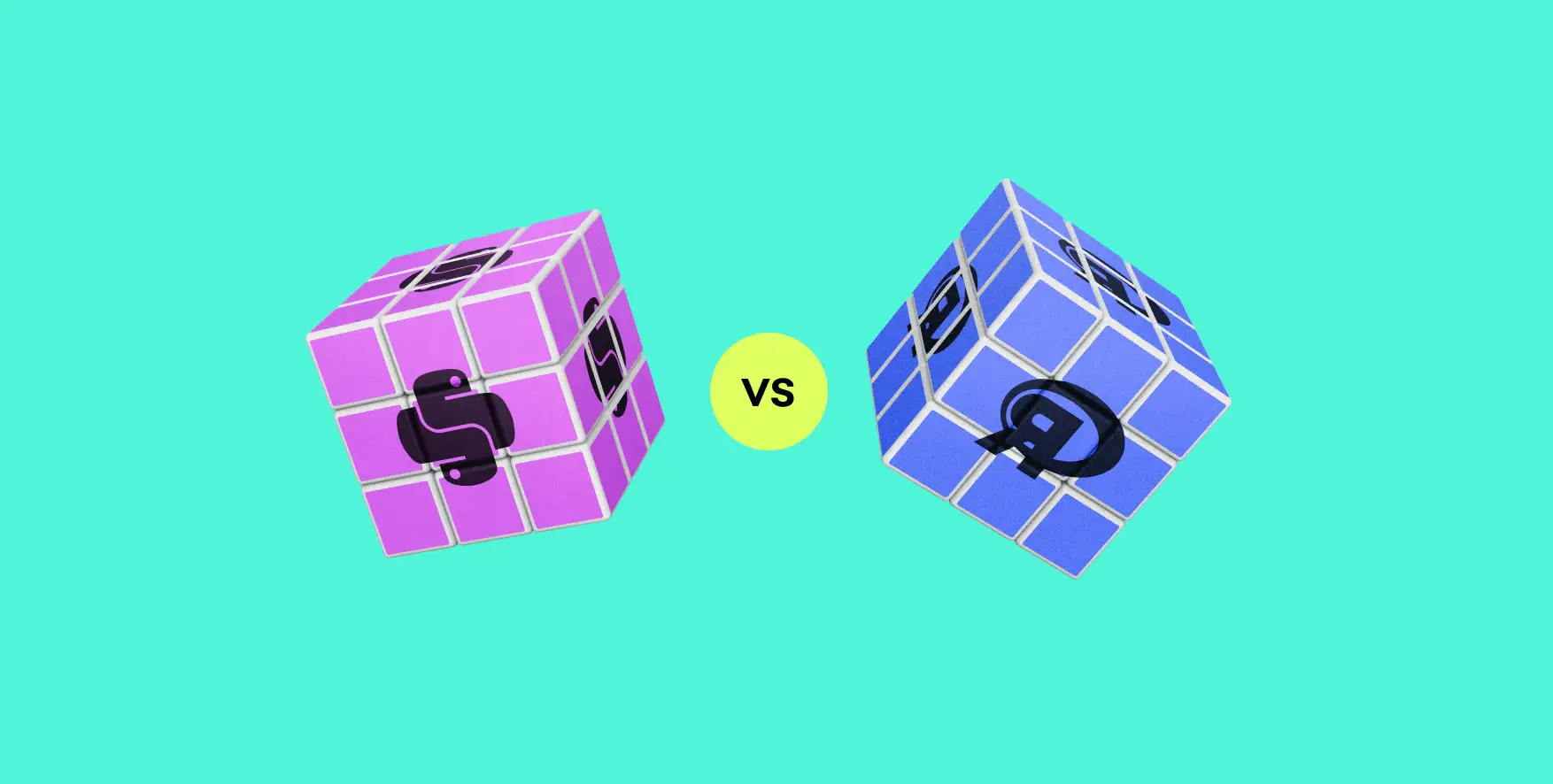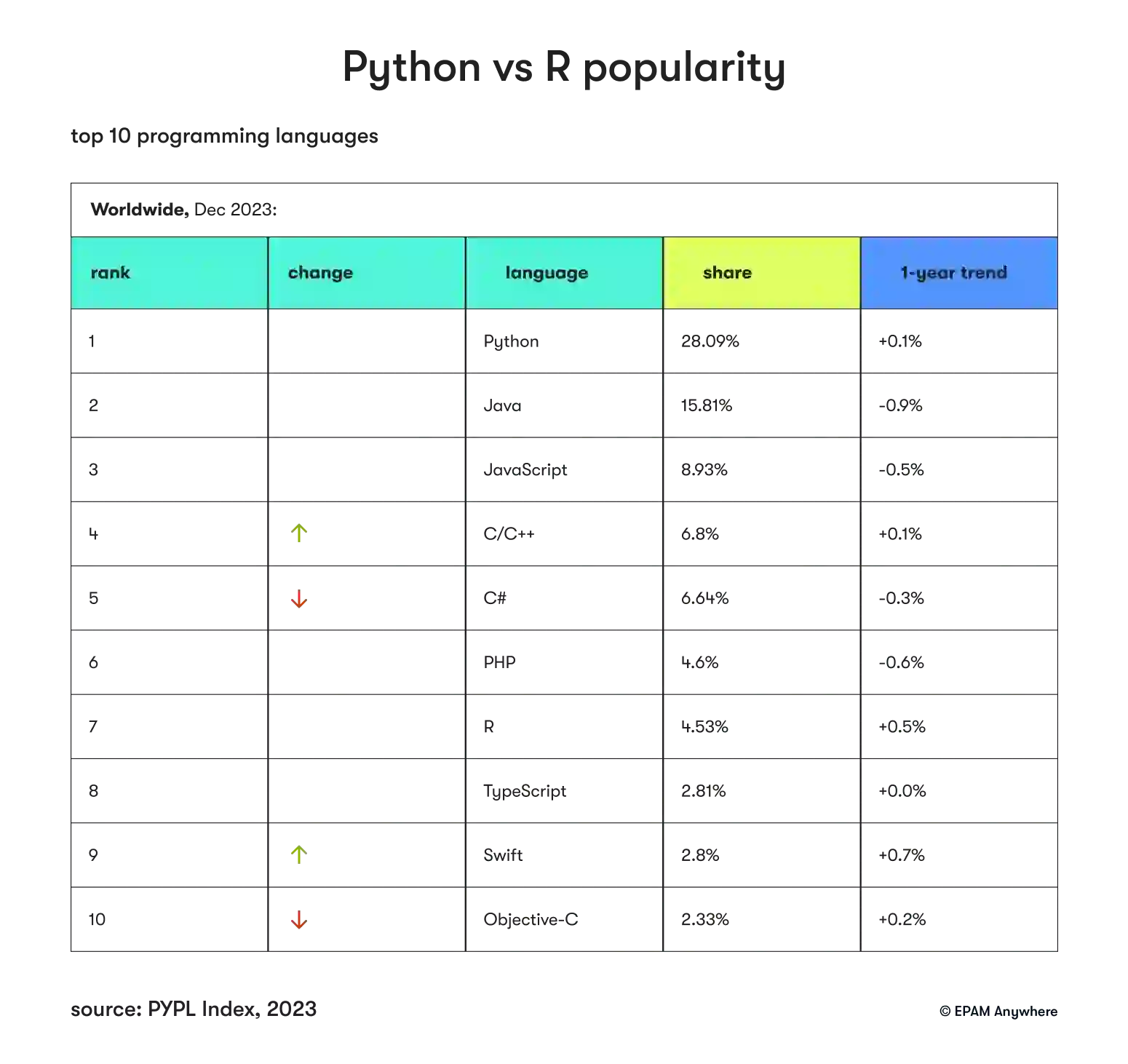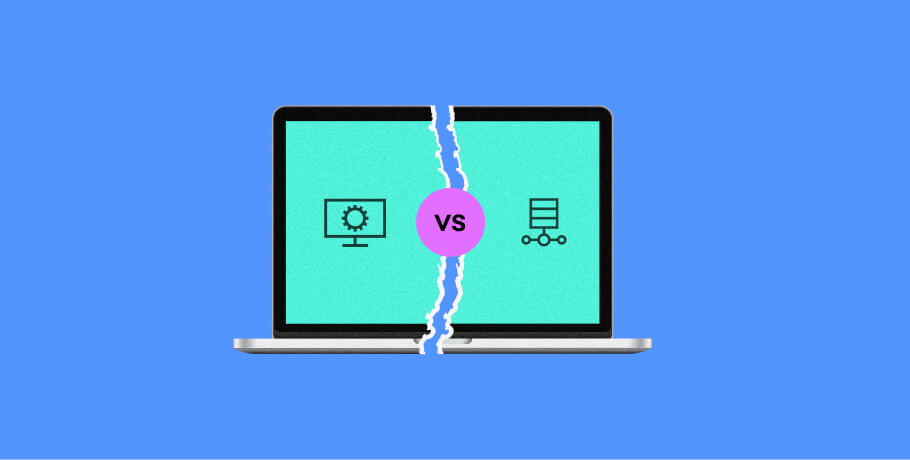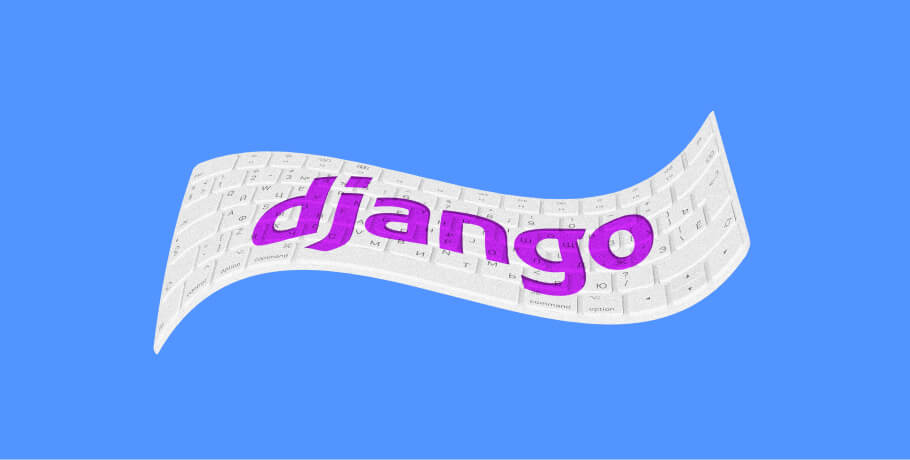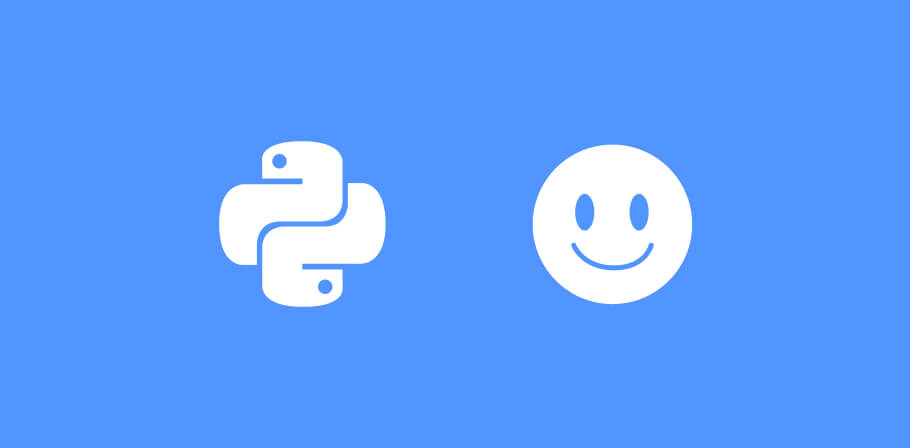If you want a career as a data scientist, you need to learn a programming language. Two of the most popular programming languages for this field are Python and R.
Both languages are open-source and free, running across operating systems like Windows, macOS, and Linux. Python programmers also consider the two relatively easy to start with, handling the many tasks behind data analysis.
To help you understand which programming language fits your needs, we've compared the two programming languages below. But first, let's dig into each language.
What is R?
R is an open-source programming language mainly used for statistical analysis and data visualization. It was created back in 1993 by statisticians, Ross Ihaka and Robert Gentleman.
Despite it being originally developed for data mining and machine learning, R has been adapted for multiple uses. This is partially thanks to the number of packages available through CRAN (the Comprehensive R Archive Network), which has exceeded 18,000.
With nearly 30 years of development, R has become a refined tool that combines statistical analysis with visualizing data. Below, you'll see some of the pros and cons of using the language.
Pros
- Easy if you know statistics: R is easier for people who already have an understanding of statistical analysis.
- Excellent for structuring code: Tools like dplyr are great for converting unstructured code into structured one.
- Great for graphical elements: R uses packages like ggplot to help create visual elements (like graphs)
- Incredible customization: Other packages, like readr and vroom, can help with data wrangling, something R traditionally struggles with if you don't have help.
Cons
- Larger projects can be slow: R is slower than other languages, especially as more objects are stored in your physical memory.
- Higher learning curve: Because R requires some understanding of statistics, it's more difficult to learn.
- No built-in security: The R programming language does not come with built-in security (you can overcome this with packages like bcrypt).
want to work with the latest tech?
Join EPAM Anywhere to revolutionize your project and get the recognition you deserve.
What is Python?
Python is a high-level general purpose language known for its excellent versatility. It was created back in 1989 by Guido van Rossum, who stuck with the project until 2018.
Programmers use Python for its object-oriented programming (OOP). These objects contain data and code in different fields, making it easy to call these pre-built Python codes to build a structured environment.
Python's popularity supports a community of programmers who release different libraries. Many of these libraries are built specifically to support data analysis, deep learning, and machine learning. Below, you'll see a bit more about the advantages and disadvantages of the programming language.
Pros
- Easier to learn: Python's object-oriented environment requires no knowledge of data analysis before you get started. Python's syntax is also closer to the English language, making it easier for English-speaking people to understand.
- Incredible versatility: Because Python is built around objects and structured data, its versatility makes it useful for everything from web development to data modeling (especially with its various libraries)
- Increases efficiency: Python's codes offer excellent control and integrations with other programming languages. This makes it so programmers won't have to rewrite code in some circumstances.
- Faster: Python renders data much faster than R because it runs using a simple syntax (which also makes it easy to read).
Cons
- Consumes more memory: As an older programming language, Python is slower than most (thanks in part to its high memory consumption)
- Overwhelming: Because Python has over 300 thousand libraries, it can take more time to dig through them to find specific ones for data science
- Not for mobile devices: Not for use on iOS and Android devices.
- Not ideal for data-driven graphics: Despite having a GUI development feature, Python isn't as helpful for converting data into usable graphics without some extra work.
Popularity of R vs Python
Python currently supports 15.7 million worldwide developers while R supports fewer than 1.4 million. This makes Python the most popular programming language out of the two.
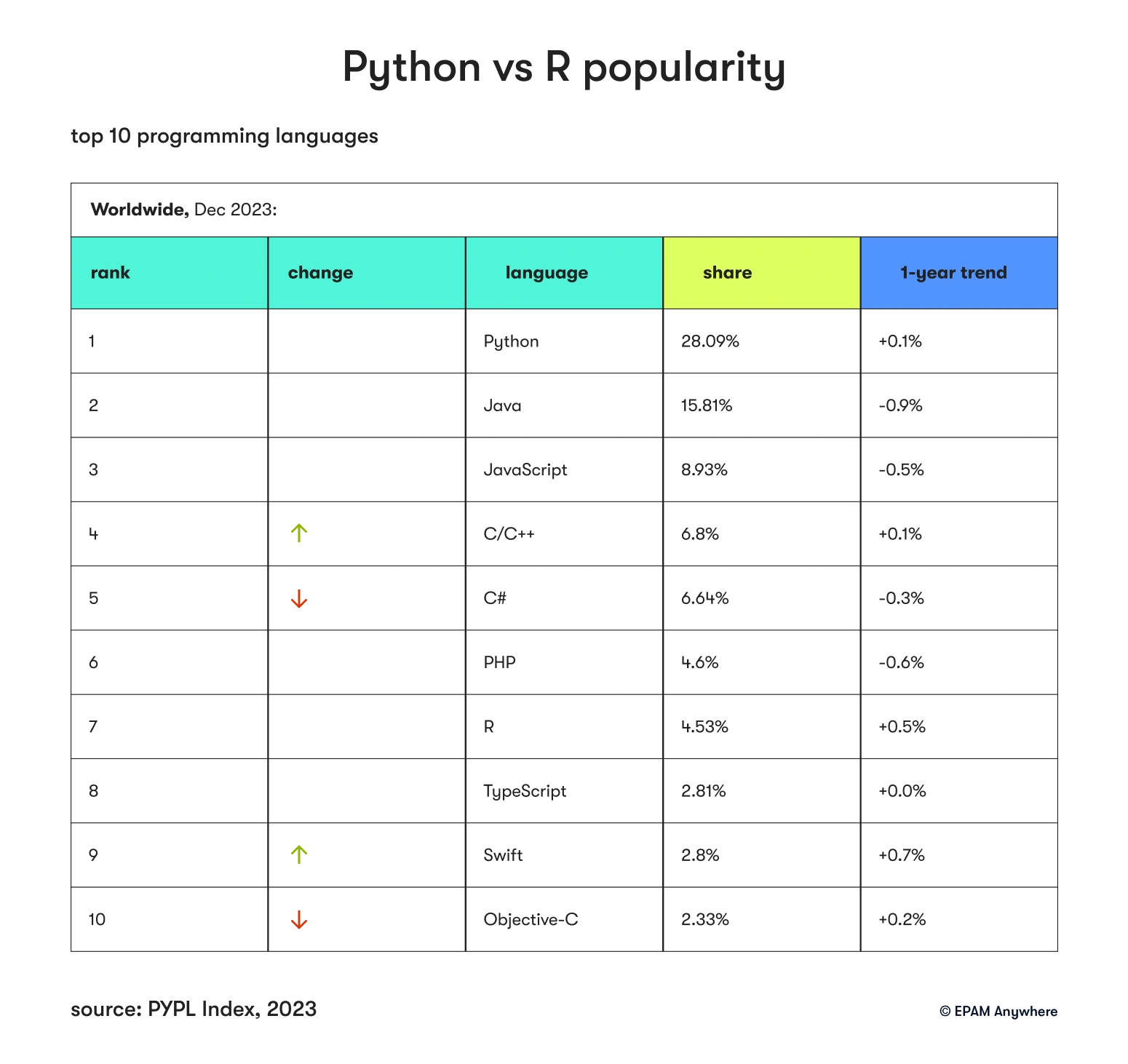
The only programming language that outpaces Python is JavaScript, which has 17.4 million developers. This is mainly-because of JavaScript's web-based application use. Python might be good for web scraping, but it's built more for backend applications.
In addition, if you look only at data modeling, Python and R are both common uses for this application. These open-source language options, alongside SQL, are better suited to data analysis and other backend duties.
Still, it's important to note that Python developers tend to be more popular, especially as work-from-home Python jobs are on the rise. Like Java once was (and still is close at number three), Python is the most popular language today. Due to R's specialization, we aren't likely to see this change for some time.
Why choose Python
Beyond it being one of the most popular programming languages in the world, you should choose Python based on these factors:
- Easy to use: If you're new to programming languages, Python is easier to pick up than most alternatives.
- Flexibility in job options: If you aren't married to data analysis, Python offers flexibility in others. For example, Python was originally built for software development. You can even use it to develop GUIs.
- Flexible data collection: Python supports data formats like CSV files, JSON files, SQL data, and Excel tables.
- Massive library: Python's popularity supports a library of 300,000 options, which is part of what makes it easy to use across multiple applications.
- If your industry demands it: Do some research on your target industry to see if your desired job uses Python. In most cases, you'll find Python of the two tools.
- Machine learning: Python is better for machine learning and big data applications.
Python isn't explicitly built for data science, requiring its users to find the right libraries that work for them. Despite this, it's got a huge number of primary users, even if all of them don't use the software for the same thing.
Why choose R
While R might be the less popular of the two due to having fewer in-demand features, its use for data science and statistical analysis is clear. Below are some cases where you might choose R:
- Better for data visualization: A big part of simplifying your statistical analysis is through graphics. R is better at visuals.
- Built for data science: When it comes to data exploration, probability analysis, and statistical reviews, R is specifically built for this field. This is why you see it used more by engineers and researchers.
- Basic web scraping: While R isn't built for web development, it's got basic scraping abilities.
- Multiple data imports: Like Python, R can import data from Excel and CSV files. You can also create R data sets using tools like Minitab or SPSS.
- Statistical analysis at sets: Because R is built for determining probabilities and creating reports related to data science, its data gathering abilities are intended to focus data sets smaller than "big”.
R is the programming language built for programmers who enjoy data analysis, statistical inquiries, and creating simple graphical reports that help a user analyze results. It's not as flexible for different kinds of tasks like Python, but it is ideal for those willing to overcome more complex syntaxes to draw deeper conclusions from their data.
R vs Python: key differences
In the field of data science, R and Python have some similarities, but you'll find more differences between the two platforms. We've already mentioned a few of them above, but here are some more:
- Number of libraries: One huge difference is in the number of libraries, where Python has over 300,000 while R is nearly 20,000.
- Visualizing data: R is better for creating a program for data visualization while Python is developed for creating interfaces, but not based on converting data into charts or other graphical elements.
- Data manipulation: R is built specifically for data exploration and manipulation while Python has to rely on the Pandas library to manipulate data.
- Speed: When it comes to getting tasks done, Python is much faster than R.
- Coding interfaces: Integrated development environments (IDEs) check code for bugs while you are mid-way through projects. Both languages use IDEs, but Python tends to get more support.
Without getting too redundant, the main difference between R and Python comes back to popularity and ease of use. Python has more features and more support, making it more likely you'll find the tools you need to get projects done. R is less popular, but better for data science tasks like analyzing data and creating visual data.
Python vs R: a comparison table
| R | Python | |
| Primary objective | Data analysis and statistics | A general-purpose language suitable for a wide range of applications, including data science |
| Primary users | Used mainly by statisticians, academics, and researchers | Utilized by programmers, developers, and professionals in various fields |
| Flexibility | Strong in statistical analysis, backed by an extensive array of packages | Highly versatile in building new models and applications, strong in machine learning and app development |
| Learning curve | Initially more challenging due to unique statistical terminology | Features a linear and smoother learning curve with clear syntax |
| Integration | Primarily runs locally, with less focus on application integration | Better integrated with web and application development |
| Task efficiency | Excels in generating primary statistical results | More efficient in deploying algorithms and larger applications |
| Database handling | Capable of handling large datasets | Also capable of handling large datasets, with superior tools for database integration |
| IDE | RStudio is the main Integrated Development Environment | Commonly used IDEs include Spyder, Jupyter Notebook, and IPython |
| Key libraries | Notable for Tidyverse, ggplot2, caret, etc. for data manipulation and visualization | Known for Numpy, Pandas, Scipy, Scikit-Learn, TensorFlow, and Seaborn for data science tasks and visualizations |
| Disadvantages | Includes slower performance, a steep learning curve, and library dependencies | Fewer specialized libraries for statistical analysis compared to R |
| Advantages | Outstanding for statistical graphs and reports, with a comprehensive package repository ideal for specific analyses | Offers greater readability, speed, and functionality, and is versatile in mathematical computation and deployment |
R vs Python: which language should you learn?
When choosing between R and Python, the language you should learn depends on your goals.
If your industry uses R, you love research, and you need something for statistical analysis, R is a better platform. It's less popular, but you'll find more use for it in these circumstances.
But if your industry uses Python, you need a more widespread programming language, or you want something that's easier to learn, Python is the better option.
Regardless of whether you're choosing Java, Ruby, Python, R, or any programming language, there are no wrong answers. Just be sure it will help you in your situation. Also, make sure you stay informed on the latest Python developer salary data.
FAQ
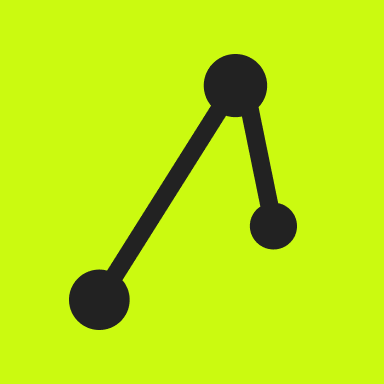
The EPAM Anywhere Editorial Team is an international collective of senior software engineers, managers and communications professionals who create, review and share their insights on technology, career, remote work, and the daily life here at Anywhere.
The EPAM Anywhere Editorial Team is an international collective of senior software engineers, managers and communications professionals who create, review and share their insights on technology, career, remote work, and the daily life here at Anywhere.
Explore our Editorial Policy to learn more about our standards for content creation.
read more
